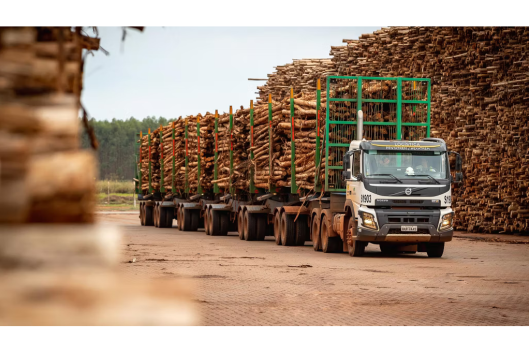This article is part of the special bulletin “Tree plantations for the carbon market: more injustice for communities and their territories”.
See here the complete bulletin.
Large-scale tree monocultures aimed at the production of pulp, timber and biomass have long been promoted and developed by companies. These monocultures have proven very harmful to neighbouring rural communities and the natural environment.(1)
The link between these plantations and carbon offsetting as a way of generating extra profits for the plantation industry is also not new. The first wave of tree plantation ventures for carbon offsetting appeared around the 2000s and was promoted by the UN’s Clean Development Mechanism (CDM). The CDM was one of three carbon trading instruments under the UN Kyoto Protocol and existed from around 2000 until 2023. In a very controversial move, the CDM accepted afforestation and reforestation, including in industrial tree plantations, as a project category that could generate carbon credits, allowing the compensation of emissions in the Global North through tree planting in the global South. It is important to remember that many of these projects had disastrous consequences for the territories where they were set up.
HISTORY REPEATS ITSELF
The first push for carbon offsetting projects involved a global wave of plantation initiatives around the 2000s. Many of these projects were characterized by conflicts with local communities and environmental impacts.
For example, in the 1990s, the FACE-Profafor project started to establish agreements with dozens of communities in the Ecuadorian Andes in order to set up pine plantations financed with Dutch capital to offset the emissions of a thermoelectric plant in the Netherlands. As a result, traditional communities lost the right to use their own lands, water sources dried up, and they were forced to rent land for their own animals to graze on.
Also in the 1990s, a similar project in Uganda established a eucalyptus plantation that led to abuses. Local villagers were beaten, shot, and blocked from entering their own land. Animals were confiscated by armed rangers protecting the "carbon trees."
Another example of this first push for tree plantation projects for carbon offsetting is that of the French-based steel producer Vallourec. This initiative also sought to sell carbon credits within the scope of the CDM. The company’s investments in eucalyptus plantations for offsetting emissions in Brazil led to violent conflicts with traditional communities, fraudulent land acquisitions and the expansion of a green desert in the region.
Unlike previous initiatives, the new round of expansion of such plantations is being developed mainly through private carbon standards but often based on methodologies and calculations developed under the CDM. These new schemes are selling carbon credits mostly in voluntary markets. In addition, they are diverse in their design (see What are the main types of tree plantation projects for the carbon business, on this bulletin) and have grown significantly in number, area and geographical scope.
How many tree plantation projects exist? How big are they?(2)
In the past three years, the number of applications to register tree plantations under private carbon standards has risen sharply (see graph below). In addition to the solid increase in the number of projects, it is important to note that the average ‘size’ of the projects is also increasing in terms of estimated emissions reduction. This suggests that the projects are growing in scale.
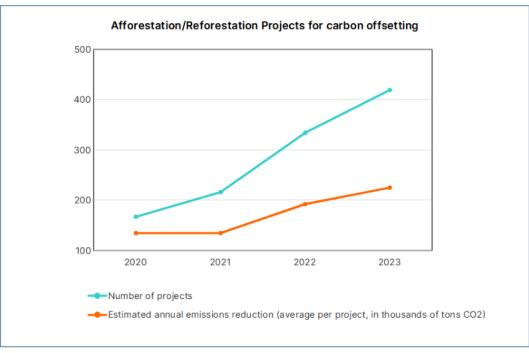
By February 2024, there were 492 afforestation and reforestation projects listed in eight private carbon standards (see table below). More than half of these projects are at different stages of implementation and therefore have not yet received approval to start issuing carbon credits. As such, they are not yet allowed to sell the carbon credits.
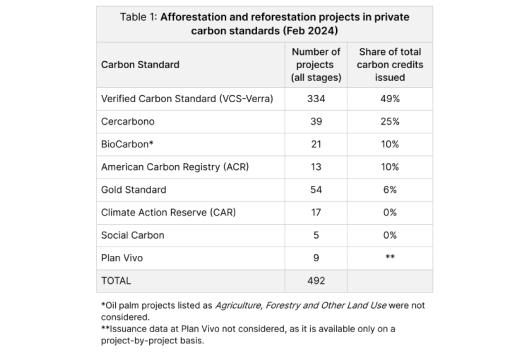
There are less than 500 tree plantation projects registered in the voluntary carbon market. This number is much lower than other categories of projects, such as Renewable Energy – which includes windmills, hydropower and solar panel projects – or Household & Community projects – e.g. cookstoves and biodigester projects. In February 2024, there were 2,300 projects from each of those two categories. However, tree plantations projects, included in the Afforestation / Reforestation category generate significantly larger volumes of carbon credits on average.(3) Combined with the sustained increase in the number of tree plantation projects in recent years, as shown in the graphic above, this indicates that the extent of land used by these plantations is also increasing.(4)
Where are tree plantations for carbon business located?
When we look at the location of afforestation and reforestation projects in the registries of private carbon certification standards, the predominance of projects in countries in the global South is noticeable. Countries in the global South currently host most of the initiatives. Among the leading countries are India (75 projects), Colombia (74) and Brazil (32). The African continent as a whole also accounts for a significant number of projects (88). Finally, China is the country that concentrates more projects on its territory, with 76 initiatives.
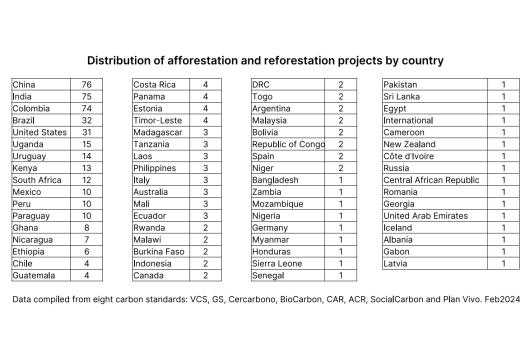
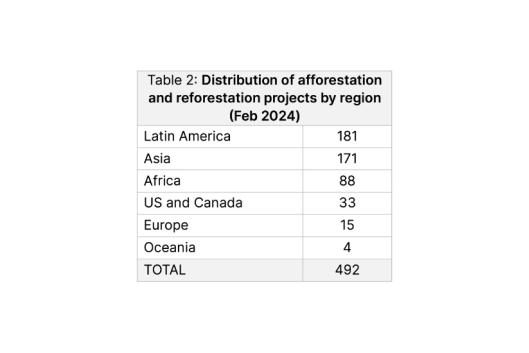
The appendix (available here) presents a list of all afforestation and reforestation projects indexed by country according to the databases of the eight private carbon standards analysed.
Who profits from tree plantations projects for carbon business?
Many different organisations and companies are directly involved in the implementation of tree plantations for carbon business. The first category consists of project proponents and developers:
• Timber and pulp & paper companies ranging from smaller entities to giant transnational corporations. Examples include the Brazilian company Suzano (which has claimed to be the world’s largest cellulose producer), Miro and Green Resources (the self-proclaimed largest forestry groups in West and East Africa, headquartered in Europe) and Klabin (which claims to be Brazil’s largest paper producer and exporter). They all have projects registered or under validation with Verra’s carbon standard VCS (Verified Carbon Standard). They also share a track record of violating communities’ rights. (Use these links to learn more about Suzano, Green Resources, Miro and Klabin).
• ‘Climate companies’ ranging from small carbon consultancies to large companies such as the world’s largest carbon trader, South Pole, whose co-founder and CEO resigned in 2023 after in-depth investigations pointed to fraudulent overstatement of credits in the company’s main project.(5) Another example is KlimatX, a company with a track record of taking over community land based on false promises. It recently rebranded as Carbon Done Right and now describes itself as ‘the world’s first smallholder farmer carbon credit reforestation company.’(6)
• Companies from various sectors with big carbon footprints. They directly own plantations or have access to carbon credits from plantation projects through investment funds that finance these initiatives. Examples include Total Energies, Eni, Danone, SAP, Michelin, Apple, Mars and many others.
• NGOs – Large conservation NGOs can be either project developers, such as TNC (The Nature Conservancy) and EcoTrust, or partners in the implementation of plantation projects, such as WWF (World Wide Fund for Nature Inc.). Other examples are NGOs with a history of working closely with corporations that have become involved as technical advisors, such as Namati and Solidaridad.
• Governments, through public companies (e.g. Colombia’s Ecopetrol and PetroChina) or directly through its departments.
Another set of entities who directly benefit from tree plantation initiatives for carbon offsetting are entities involved in the process of creating carbon credits. These include the organisations that own the certification standards and the auditors hired to carry out the validation and verification procedures required by the certification standards. As shown in Table 1 (see How many tree plantation projects exist? How big are they? above), in the case of afforestation and reforestation projects, Verra’s carbon standard stands out with nearly 70 percent of the projects and almost 50 percent of the credits issued to date.
VERRA AND CARBON CERTIFICATION
The world’s largest creator of carbon offsets from land use activities is Verra. At the end of 2023, it had issued more than 1.2 billion carbon credits. Although it promotes itself as a non-profit organisation, it operates like a company. Verra charges project proponents US$ 0.20 for each credit issued, among many other fees.(7) With compensation and benefits over US$ 400,000 a year,(8) its founding CEO resigned in 2023 after scandals revealed that projects using Verra’s methodologies had sold millions of junk carbon credits.
The scandals involving Verra projects include the Kariba project in Zimbabwe, the flagship initiative of the world's largest carbon trader, South Pole. With a gaping hole in Verra's certification system that went unnoticed for 10 years, the project actually resulted in more carbon emissions. Another investigation analysed 32 Verra projects and concluded that 94 percent of the credits issued were overestimated and should not have been approved, and that only six projects did not have their effectiveness overestimated.
However, the problem goes beyond Verra. The process of certifying carbon projects has inherent flaws that make it a complete farce. To better understand how the carbon certification process works, see Carbon Certification: “The Emperor’s New Clothes.”
The appendix includes a list of all project proponents listed on the databases of the eight private carbon standards analysed.
(1) For more information, see the WRM publications “What could be wrong about planting trees?” and “12 replies to 12 lies about industrial tree plantations”.
(2) The figures and information presented in the subsequent sections refer to a review of projects under the Afforestation and Reforestation category, as defined by the main private carbon standards. This means that this analysis does not include wetland restoration projects, which occasionally consist of planting trees for carbon markets too, although in a number of projects more than 10 times smaller than those in the Afforestation and Reforestation category. It also does not include data from independent tree plantation projects (see What are the main types of tree plantation projects for the carbon business, on this bulletin) or from those within national schemes that are not necessarily listed in the private carbon registries.
(3) The average estimate of emission equivalent reduction per project per year is as follows:
• 225,040 tCO2 for Afforestation/Reforestation projects;
• 187,259 tCO2 for Household & Community projects;
• 119,397 tCO2 for Renewable Energy projects.
The figures are based on the database developed by the Berkeley Carbon Trading Project.
(4) Private standards datasets do not provide information on the total area encompassed by the projects. To obtain this information, it is necessary to consult the projects pages and documents on an individual basis.
(5) Follow the Money, 2023. Showcase project by the world's biggest carbon trader actually resulted in more carbon emissions.
(6) City A.M., 2024. Green AI Carbon platform AIMs for London listing amid lack of confidence in market.
(7) Verra, 2023. VCS Program Fee Schedule, v4.3.
(8) ProPublica, 2024. Nonprofit Explorer search engine.
